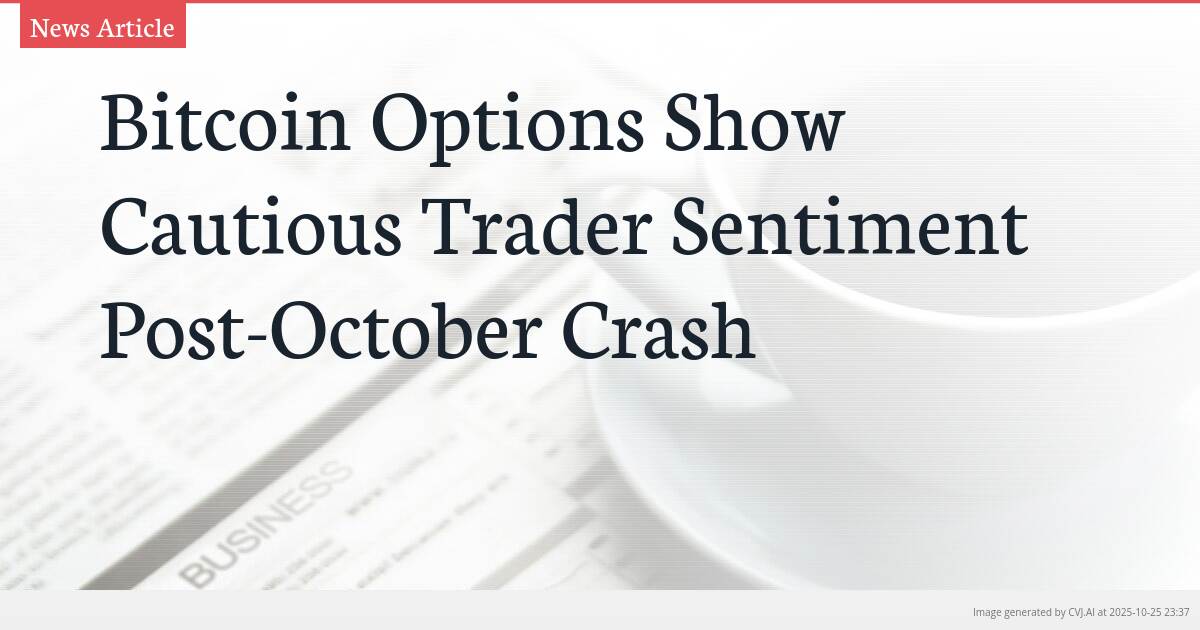This summary text is fully AI-generated and may therefore contain errors or be incomplete.
Introduction
The Bitcoin options market is revealing a cautious stance among traders despite recent price recovery to around $120,000. Following October’s massive $19 billion deleveraging event, data from Glassnode shows persistent demand for downside protection, elevated short-term volatility pricing near 50%, and the disappearance of the volatility carry trade. Institutional players are adopting defensive positioning while maintaining exposure, balancing optimism with sober risk management.
Key Points
- October's market collapse wiped out over $19 billion in leveraged positions, creating a 'cleaner' market structure with reset open interest now rebuilding
- Short-dated implied volatility remains elevated near 50%, indicating traders are paying premium for near-term insurance against potential shocks
- The volatility carry trade has vanished as realized and implied volatility converge, forcing traders to actively manage exposure rather than collect easy yield
Market Structure Resets After Historic Deleveraging
The backdrop for current Bitcoin options activity is a market still digesting one of the sharpest deleveraging events in crypto history. October’s collapse wiped out over $19 billion in leveraged positions, vaporizing tens of billions in leveraged bets and leaving futures open interest at its lowest in months. According to Glassnode’s latest Options Weekly report, open interest has since reset and is now rising again into Q4, creating what analysts describe as a ‘cleaner’ market structure free from expiry-driven noise.
This reset occurred as traders repositioned following the early-October washout triggered by President Trump’s renewed tariff threats against China. The market shock jolted implied volatility from 40% to over 60%, and while it has cooled slightly since, volatility remains well above pre-crash levels. The stickiness in implied volatility suggests traders remain unsettled about liquidity and autoredeleveraging risk even as Bitcoin has clawed its way back from the October lows.
Elevated Volatility and Defensive Skew Patterns
The volatility term structure reveals persistent trader wariness despite Bitcoin’s recovery. Short-dated implied volatility remains elevated, hovering near 50%, indicating traders are paying premium for near-term insurance against potential shocks rather than expressing faith in a smooth rebound. This steepening at the short end contrasts with longer-dated contracts, creating a term structure that signals ongoing caution about further market disruptions.
Skew indicators echo the same defensive story. Glassnode data shows persistent demand for puts, with the 25-delta skew several volatility points higher toward downside protection. This pattern has persisted even after Bitcoin’s brief bounce to around $120,000, suggesting institutional traders have been layering in hedges while taking profits into strength. Glassnode analysts characterize this as ‘defensive positioning’ rather than capitulation, indicating the market isn’t screaming risk-off but maintains a cautious appetite for upside.
The current environment marks a stark contrast to early 2025, when short-volatility strategies dominated. The once-lucrative volatility carry trade—shorting options to earn premium as realized volatility stayed dormant—has effectively vanished with realized and implied volatility now converging. This disappearance of easy income has forced traders to actively manage exposure rather than simply collect yield.
Defensive Flows Dominate Record Options Expiry
Recent option flows confirm the market’s defensive bias remains entrenched. Approximately $31 billion in Bitcoin options are set to expire during Halloween week, representing one of the largest expiries on record. The structure of these contracts reveals telling patterns: heavy put concentration around the $100,000 strike and calls clustered near $120,000, almost perfectly bracketing Bitcoin’s recent trading range.
This positioning creates a market dynamic where dealers are short gamma on the downside and long on the upside—a setup that tends to suppress rallies and intensify selloffs. Bloomberg’s early-October reporting had described traders piling into $140,000 calls during Bitcoin’s euphoric move above $126,000, but as the rally faded, that bullish momentum gave way to hedging and profit-taking. The current defensive flows demonstrate how quickly sentiment shifted following October’s volatility shock.
Awaiting Macro Catalysts for Directional Clarity
For now, the next major volatility reset hinges on macroeconomic data. Traders are holding off until the upcoming U.S. CPI report after the government shutdown backlog clears, which will likely shape cross-asset volatility pricing. Glassnode analysts note that with the current compressed setup—elevated front-end volatility, defensive skew, and a fading carry trade—any macro jolt could quickly swing the market back toward directional extremes.
The Bitcoin options market is ultimately showing less euphoria and more wisdom following October’s shock. Traders have learned from the $19 billion deleveraging event and are balancing the optimism of ‘Uptober’ with an unusually sober approach to risk management. Rather than volatility disappearing, it’s being managed more carefully—a sign of maturation in the crypto derivatives market as participants navigate uncertain macroeconomic conditions and geopolitical tensions between the United States and China.
📎 Read the original article on cryptoslate.com

